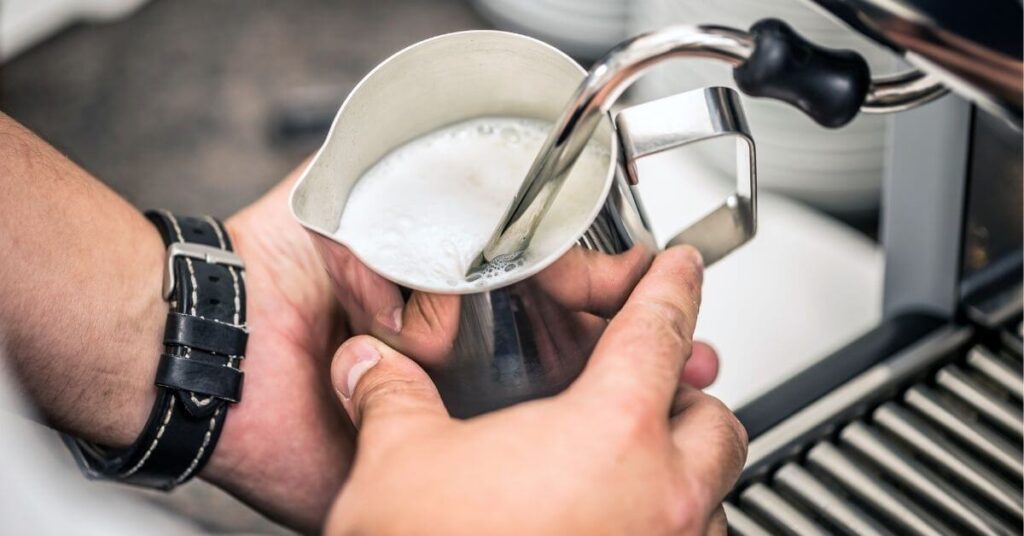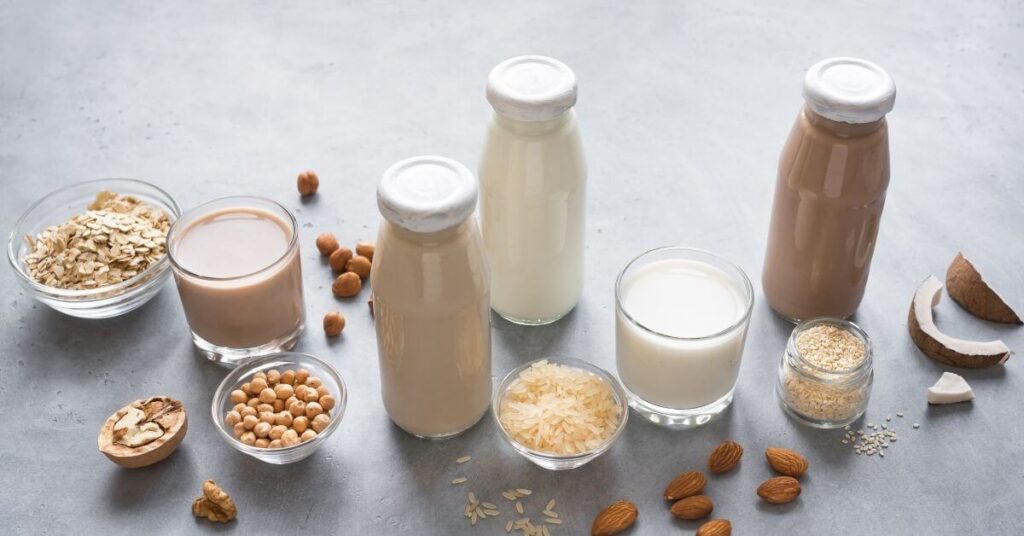As a long-time coffee lover and the closest thing my family has to a barista, I’m often asked all kinds of coffee questions. A common one is about the difference between steamed milk vs frothed milk.
Steamed milk is milk that’s been heated, aerated, and stirred using jets of steam. Because it’s been created with steam, it’s filled with microbubbles, has a silky texture, and has a sweeter flavor than regular milk. By comparison, foamed milk has larger foam bubbles, and a dryer and stiffer texture.
As you can imagine, these two types of milk can create completely different coffee drinks!
If you want to learn more, including what kinds of milk work best and what kind of coffee drinks you can make, then read on!
What Is Steamed Milk?
I know we touched on this earlier, but here we’ll go into a bit more detail.
Steamed milk is just regular milk that’s been exposed to pressurized steam. This process introduces air, water, heat, and turbulence to the milk.
As the cold milk is heated and stirred the fats break down which creates micro air bubbles. And at the same time, the heat breaks the milk’s complex carbohydrates into simpler sugars which make the milk taste sweeter.
The end result is a heavier, denser, and sweeter milk. When steamed milk is taken against the backdrop of a good espresso, it can be a marriage made in heaven.
How To Prepare Steamed Milk

To achieve this with a steam wand, then I always ensure that the tip of the wand is fully submerged in the milk, I will always keep it towards one side of the jug and have the jug slightly tilted to ensure it is fully submerged.
This technique also allows for a more even heating of the milk.
But, if you like foamier steamed milk, then this can be achieved by simply raising the wand slightly to incorporate more air into the mix.
Effectively, this means you are controlling the froth content of your milk by simply adjusting the depth of your wand, the closer to the surface of the milk, the foamier it will become, and vice versa.
A word about the pitcher size, even milk that is steamed ‘flat’ will expand when heated, so it is important to have plenty of spare capacity in your milk pitcher, normally I would only fill a milk pitcher to around one-third of its capacity.
This expansion is due to the tiny bubbles, also known as micro-foam, that give the milk its smooth, almost silky consistency.
Related Posts:
- How Is Instant Coffee Made?
- How Many TBSP Of Coffee Per Cup? Here’s How To Get It Right!
- What Milk Froths Best? Perfect Picks For Your Coffee!
Which Milk Is Best For Steamed Milk?

Firstly, the fresher the better, older milk doesn’t hold the bubbles, as well as some of the proteins and fats, have already started to break down naturally, not that you shouldn’t use older milk, but the results won’t be quite as nice.
Also, it should be obvious, but I should also mention that the milk should be cold to start with.
The fat content is another aspect to consider, as a general rule of thumb lower fat milk will give you more foam and stiffer bubbles, this is due to the higher protein and sugar content of the lighter milk.
Whereas higher fat content will take longer to break down and create the micro-foam. However, with some perseverance, it is still possible to get a good, creamy steamed milk with a light micro-foam even using full-fat milk.
If you are wanting to check out some non-dairy products, then it is quite possible to use them. For example, coconut milk with its high-fat content produces a nice creamy steamed milk.
Just be aware that plant-based milk like soy or almond milk will generally burn at a low temperature than the dairy equivalent, it is still doable but be sure to keep a close eye on it.
What Is Frothed Milk?
In a word, foamy. Of course, when you look at the science it is more than just that, but how else would you describe it? Well, delicious of course, creamy and sweet, and just about the perfect mixer for a host of hot drinks.
For the perfect cappuccino or mocha good, foamed milk is essential, but just what is it? And how do you make that perfect frothed milk?
Whilst frothed and steamed milk might seem similar, in some ways they are totally different.
Frothed milk is known in the trade as “dry milk’”. It is less liquid-like than steamed milk and due to high aeration is fluffier and holds its shape more than steamed milk.

How To Prepare Frothed Milk
This can be achieved in a number of ways, the simple steam wand attached to an espresso machine can be used. In this method it is necessary to make sure the tip of the wand is as close to the surface of the milk as possible; this is to ensure getting as much air into the milk as possible.
Some steam wands have a cappuccino setting specifically to allow more air into the mix.
Don’t despair if you haven’t got a steam wand though, frothed milk can be prepared in other ways too!
Even if all you’ve got to hand is a sealable jar, it is still possible to froth milk. Simply fill the jar to no more than a third capacity and shake the milk vigorously until it has doubled in size.
Once this is done remove the lid and place the jar in a microwave oven, pay close attention so that it doesn’t boil over and you lose all that precious froth. After about 30 seconds to a minute, you will have the perfect frothed milk.
You can also use a French press, simply fill it to no more than a third and use the press as pump and keep pumping until the right consistency is reached.
Or you could simply use a normal food mixer.
And if none of these options appeals, there is a huge range of custom-designed milk-frothers on the market.
Related Posts:
- How Is Instant Coffee Made?
- How Many TBSP Of Coffee Per Cup? Here’s How To Get It Right!
- What Milk Froths Best? Perfect Picks For Your Coffee!
What Is The Best Milk To Use For Frothing?
Non-fat milk is best for creating big bubbles. But full-fat milk is better for a softer, tastier foam.
As with steamed milk and for the same reasons, use milk that is as fresh as possible.
Non-fat or skimmed milk is best for getting those big bubbles essential to a good foam, if you’re just starting out try this type first. You get a nice airy texture at the cost of a little flavor. Stepping it up to 2% fat, you get a better balance with a milk that still foams easy and has improved flavor.
Full fat milk will require a bit more work and will never get quite as frothy as the lighter milk due to the higher fat content. But if you prefer a lot more flavor and a bit less foam, then with some application, the results can taste delicious.
You can produce froth with plant-based milk, such as soy, as well. But the foam won’t last as long, as the protein structure of these milks doesn’t fully support the bubbles.
What’s The Difference Between Steamed Milk vs Frothed Milk?

The structure and density of your milk is the key difference between the two. Steamed milk is denser and creamier, with tiny bubbles forming a micro-foam that is silky smooth and caramel in flavor.
Frothed milk is more voluminous with significantly more foam with larger bubbles, it has a light and airy dryness about it, while still maintaining much of the silky sweet texture and flavor of the steamed milk.
Popular Drinks That Use Steamed vs Frothed Milk
There are a huge number of recipes that call for steamed and frothed milk, here we will have a look at some of the popular coffee drinks.
Of course, with steamed milk, you would have to start with that old favorite, the flat white. Usually made with a shot of espresso and milk that has been steamed while adding a minimum amount of foam.
Another common drink that uses steamed milk is the Latte; a Latte usually contains about 1-2 ounces of espresso topped up with 8-16 ounces of steamed milk, this too usually has a very thin layer of micro-foam.
With frothed milk the starting place must be the good old cappuccino. A typical cappuccino in the traditional sense would contain 1-2 ounces of espresso and 3-4 ounces of frothed milk. The key to a good cappuccino is having the milk frothed correctly.
One more is the macchiato; this is a coffee where the frothed milk sits on top of the espresso and isn’t mixed with it.
Related Posts:
- How Is Instant Coffee Made?
- How Many TBSP Of Coffee Per Cup? Here’s How To Get It Right!
- What Milk Froths Best? Perfect Picks For Your Coffee!
Tips On How To Make Steamed Milk vs Frothed Milk

A lot of this is down to what equipment you use, but one piece of general advice is to remember this. For frothed milk, introduce as much air into the milk as you can, and for steamed milk, introduce only as necessary to suit your own taste. Some other tips are: –
- Use the freshest milk possible
- Use the right type of milk to suit your needs
- Never burn the milk
- Practice makes perfect.
Steamed Milk vs Frothed Milk – The Bottom Line
You’ll often see steamed milk and frothed milk used interchangeably. But after reading this article, I hope you see that they’re very different!
Frothed milk is basically protein bubbles and the fat in the milk can actually prevent good frothing. By comparison, the fat content in milk makes steamed milk that much better!
They have different textures, tastes and are used for different types of coffee drinks. So, the next time you’re preparing a coffee drink, make sure you add the right type of milk!
Cheers!

KEEP READING
- Are Moka Pots Dishwasher Safe? Here’s What To Expect!

- Does Espresso Break A Fast? Must Know Facts!

- Why Does My Coffee Taste Metallic? (7 Causes And Solutions)

- Coffee Syrup vs Coffee Sauce (Side By Side Comparison!)

- Coffee Syrups vs Coffee Creamers (Which One To Pick?)


Idalmis is co-owner of Coffee Break Lovers. She is a Cuban coffee enthusiast that is passionate about coffee and coffee culture.

